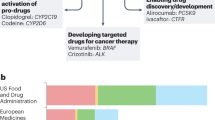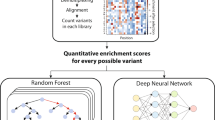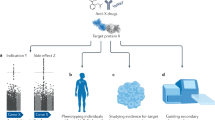Abstract
Pharmacogenomics and pharmacogenetics provide methodologies that can lead to DNA-based tests to improve drug selection, identify optimal dosing, maximize drug efficacy or minimize the risk of toxicity. Rapid advances in basic research have identified many opportunities for the development of 'personalized' treatments for individuals and/or subsets of patients defined by genetic and/or genomic tests. However, the integration of these tests into routine clinical practice remains a major multidisciplinary challenge, and even for well-established biomarkers there has been little progress. Here, we consider this challenge from a regulatory perspective, highlighting recent initiatives from the FDA that aim to facilitate the integration of pharmacogenetics and pharmacogenomics into drug development and clinical practice.
This is a preview of subscription content, access via your institution
Access options
Subscribe to this journal
Receive 12 print issues and online access
$209.00 per year
only $17.42 per issue
Buy this article
- Purchase on Springer Link
- Instant access to full article PDF
Prices may be subject to local taxes which are calculated during checkout



Similar content being viewed by others
References
DiMasi, J., Hansen, R. W. & Grabowski, H. G. The price of innovation: new estimates of drug development costs. J. Health Econ. 22, 151–185 (2003).
Gilbert, J. Rebuilding big PhRMA's business model. In Vivo November, 73–80 (2003).
Tufts CDSS quantifies savings from boosting new drug R&D efficiency. Tufts CSDD Impact Report 4, 1–4 (2002).
Lynch, T. J. et al. Activating mutations in the epidermal growth factor receptor underlying responsiveness of non-small cell lung cancer to gefitinib. N. Eng. J. Med. 350, 2129–2139 (2004).
Guillermo Paez, J. et al. EGFR mutations in lung cancer: correlation with clinical response to gefitinib. Science 304, 1497–1500 (2004).
Innovation or Stagnation? Challenge and Opportunity on the Critical Path to New Medical Products [online], <http://www.fda.gov/oc/initiatives/criticalpath/whitepaper.html> (2004).
Lesko, L. J. & Woodcock, J. Pharmacogenomic-guided drug development: regulatory perspective. Pharmacogenomics J. 2, 20–24 (2002).
Lesko, L. J. et al. Pharmacogenetics and pharmacogenomics in drug development and regulatory decision making: report of the first FDA-PWG-PHRMA-DRUSAFE workshop. J. Clin. Pharmacol. 43, 342–358 (2003).
Salerno, R. A. & Lesko, L. J. Pharmacogenomics in drug development and regulatory decision-making: the genomic data submission (GDS) proposal. Pharmacogenomics 5, 25–30 (2004).
Salerno, R. A. & Lesko, L. J. Pharmacogenomic data: FDA voluntary and required submission guidance. Pharmacogenomics 5, 503–505 (2004).
Peck, C. C., Temple, R. T. & Collins, J. Understanding consequences of concurrent therapies. JAMA 269, 1513–1518 (1993).
Acknowledgements
We would like to acknowledge the helpful comments of our FDA colleagues F. Frueh, S.-M. Huang and A. Rudman.
Author information
Authors and Affiliations
Corresponding author
Ethics declarations
Competing interests
The authors declare no competing financial interests.
Related links
Related links
DATABASES
Entrez Gene
National Cancer Institute Cancer Topics
Online Mendelian Inheritance in Man
FURTHER INFORMATION
Center for Drug Evaluation and Research
Glossary
- ALLELES
-
Different or alternative forms of the same gene that can occupy a particular locus on a specific chromosome. Humans have two alleles at that location, one on each chromosome of a homologous pair.
- AREA-UNDER-CURVE
-
(AUC). A metric that summarizes serum or plasma drug concentrations measured over time (for example, 24 hours) in a given individual following the administration of a drug. The AUC is interpreted as the total systemic exposure and is an index of how much of a drug reaches the bloodstream in a set period of time. AUC is also a means to compare the bioavailability of drug from a drug product.
- BAYESIAN STATISTICS
-
A statistical method of analysis that incorporates prior knowledge (for example, on safety and efficacy parameters), specifications of prior distributions and accumulated clinical data experience into making probability calculations and designing future clinical trials.
- BIOLOGIC LICENSE APPLICATION
-
A formal application analogous to a New Drug Application, but for biotechnology-derived pharmaceuticals (for example, complex, large molecules).
- BIOMARKER
-
A characteristic that is objectively measured and evaluated as an indicator of normal biological processes, pathogenic processes or pharmacological responses to a therapeutic intervention.
- HAPLOTYPE
-
A set or combination of alleles or linked genetic markers found on a single chromosome, which tend to be inherited together in a given individual.
- INVESTIGATIONAL NEW DRUG APPLICATION
-
Before initiating any clinical trials of a new drug in humans, a drug sponsor must submit an Investigational New Drug application (IND) to the FDA. The IND contains three broad categories of information: data from animal pharmacology and toxicology studies, manufacturing information, and clinical protocols and investigator information.
- NEW DRUG APPLICATION
-
A formal application that serves as a vehicle through which sponsors propose that the FDA approve a new pharmaceutical (for example, traditional small molecules) for sale and marketing in the United States. When the investigational phase of a drug is completed, the manufacturer submits the results of all the studies to the FDA in a New Drug Application (NDA) for review by FDA officials. The purpose of the NDA is for the FDA to decide if the drug meets the statutory standards for safety, effectiveness and benefit/risk for its intended use, and labelling and manufacturing quality.
- NEUTROPENIA
-
An abnormal decrease in the number of white blood cells in the blood (as measured by an absolute neutrophil count), which increases the risk of infection and fever. It usually occurs as a result of chemotherapy.
- SINGLE-NUCLEOTIDE POLYMORPHISM MAPS
-
A diagram or overview of a stretch of DNA containing single-nucleotide polymorphisms (SNPs). SNPs are DNA sequence variations that occur when a single nucleotide (A, T, C or G) in the genome sequence is altered in different individuals. A map of SNPs across the genome allows genetic traits to be localized by statistical association with the specific region of the genome that is marked by the SNP or multiple nearby SNPs.
Rights and permissions
About this article
Cite this article
Lesko, L., Woodcock, J. Translation of pharmacogenomics and pharmacogenetics: a regulatory perspective. Nat Rev Drug Discov 3, 763–769 (2004). https://doi.org/10.1038/nrd1499
Issue Date:
DOI: https://doi.org/10.1038/nrd1499
This article is cited by
-
A review of deep learning applications in human genomics using next-generation sequencing data
Human Genomics (2022)
-
Pharmacogenomics-based practice in North Cyprus: its adoption by pharmacists and their attitudes and knowledge
International Journal of Clinical Pharmacy (2019)
-
Considerations of Human Health Risk Assessment in Chemical Accident: Suggestions from a Toxicogenomic Approach
Toxicology and Environmental Health Sciences (2018)
-
A toxicogenomic study for the investigation of genotoxicity-related signaling networks in long-term and low dose lead exposed rat kidney
Molecular & Cellular Toxicology (2016)
-
The Coriell personalized medicine collaborative pharmacogenomics appraisal, evidence scoring and interpretation system
Genome Medicine (2013)



